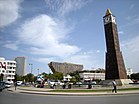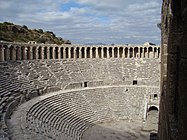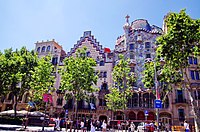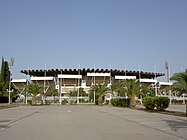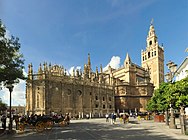New Tyria
This article is incomplete because it is pending further input from participants, or it is a work-in-progress by one author. Please comment on this article's talk page to share your input, comments and questions. Note: To contribute to this article, you may need to seek help from the author(s) of this page. |
New Tyria
| |
|---|---|
| The City of New Tyria | |
|
Clockwise from top: New Tyria cityscape, Hall of Workers' Councils, Šidduni Square, The Latin Ampitheatre, National University of Tyreseia Wechsler Library | |
| Nicknames: The Big Olive, NTC | |
| Country | |
| Metropolis | Tyria |
| Region | Greater Tyria |
| Municipal Councils | List
|
| Rebuilt | 180s BCE |
| Government | |
| • Type | Urban association |
| • Body | Tyria Multi-Municipal Council |
| Area | |
| • Capital city | 1,918 km2 (741 sq mi) |
| • Metro | 30,595 km2 (11,813 sq mi) |
| Population (2020) | |
| • Capital city | 8,764,231 |
| • Density | 4,600/km2 (12,000/sq mi) |
| Time zone | UTC+1 (Central Scipia Time) |
| Postal code | SH-001 to SH-999 |
| Area code | 11 to 19 |
New Tyria is the capital and largest city in the Workers' Federation of Tyreseia, with a population of 8,764,231 as of the 2020 Census. It is located along the X Bay, the X River and the Periclean Sea.
Though the city lacks official legal status as the nation's capital city, New Tyria has nevertheless played an outsized role in Tyreseia's history, politics, and culture. Most of the nation's governmental institutions and unions are headquartered in the city, along with the world's embassies and diplomatic missions. Much of the administrative apparatus of the Rubric Coast Consortium is also based in New Tyria. The city also serves as a transportation and service hub, playing host to the nation's only international airport and its largest railway stations.
History
In the aftermath of a devastating earthquake in 191 BCE, the ancient and eponymous capital city of the Tyrian civilization, Tyria, was largely destroyed. At the time, the Latin Empire had recently concluded its intervention in the civil war between the merchant houses of Hiram and Eshmun. As the Latin-backed Hiramites had won, the legions present in the region were seeking a place to establish a new Hiramite client capital. The other major Tyrian city-states, including the Hiramite home base of Tsabratan, had suffered even greater destruction from war, pestilence, famine and the earthquake. As such, much to the Hiramites' chagrin, the capital site was selected a few kilometers east of old Tyria, along the X River. Much rubble from the old city was repurposed in building the new, with some ancient Tyrian monumental structures being cut down and rebuilt as they once were. Through the recycling of building material and whole buildings alike, the core of New Tyria was established in around 179 BCE, with the harbor and Temple of Jupiter (a reconstructed temple to Ba'al Hammon) as the focii of the design. The process of ignoring the Hiramites' choice of capital and desecrating Tyrian religious sites proved too much for many to bear, and many Hiramites rose up in revolt in 178 CE. The revolt, concentrated in the west and featuring some Eshmunites fighting alongside their former sworn enemy, was swiftly put down as numerous Latin forces had arrived to aid in New Tyria's construction and in securing their new client kingdom. In the aftermath, the region now known as Tyreseia was quickly transformed into a more directly-administrated province of the Empire, with the once-great Houses of Eshmun and Hiram being forcibly dissolved.
During the Latin period, the city saw a quick explosion in growth, seeing many peoples of both Tyrian and Latin descent migrating into the city. Other minority groups, including the city's first Jewish populations, ended up within New Tyria's walls as the combination of riverine transport, maritime trade and Latin financial support made the city grow rapidly in just a few centuries. Even after the Latin withdrawal, the city continued to grow, coming under the control of the eponymous Tyrian Republic. Formed after the collapse of Latin authority, the Republic was ruled by a collegium of influential elders and merchants, governing the city-state's affairs. The period following the Latin withdrawal saw alternating stages of stagnation and minor growth until the early 10th century. The concurrent onset of the Coptic Golden Age saw the headquarters of the Coptic Church move from the ghost town of Koptos to the then-outskirts of New Tyria. The epicenter of secular and religious learning was centered on the city, leading to the construction of the Bibliotheca Tyriensis, or the Tyrian Library. This library, and later associated Collegium, survived several invasions through the centuries and became the National University of Tyreseia.
Geography
The site of New Tyria lays on strategic ground. The city lies along both the Periclean Sea coast and the X, a large delta branch of the Heshek River. This branch was artificially widened by successive Latin, medieval, and early-modern projects, making it easy to transport goods and people from the Periclean down the channel to the Heshek and vice versa.
Climate
Government
Economy
Infrastructure
Transportation
New Tyria is bound together with numerous forms of mass transit.
Education
Culture
Sports
Cuisine
Entertainment
Landmarks
The city is dotted with landmarks, many of which reflecting the extravagant building projects of the Princes of New Tyria in the mid-to-late-19th centuries. Much of the city's modern buildings of note, in terms of both public architecture and private, either embody the styles of Belisarian Neoclassicism or later works of the Brutalist school. A notable exception includes the Latin Ampitheatre on the southeast rim of the city, dating to late Antiquity and serving as one of the most well-preserved examples of an ancient public ampitheatre. On the other end of the spectrum is the covered walkways and cloistered alleyways of the Jewish Quarter, which remain largely unchanged from the Medieval era. As the capital and most populous city in Tyreseia, New Tyria possesses numerous landmarks that denote its status as a hub for bureaucracy, arts, culture, trade, and religion. The Palachu Naxunalu (National Palace), begun in the 1850s as a palace and seat of government for the New Tyrian princes, became a symbol of princely decadence during the Resurgencha and the site of many a riot and attempted coup. Following its occupation, it became the seat for the turbulent Tyreseian Republic's Provisional Government. Work controversially continued on completing the building, and strongman Azmelqart Šidduni famously stormed the Palachu with his loyalist soldiers in the 1883 Revolution. The nearby Arcu dji Triumfu (Arch of Triumph) was consecrated in 1928 to celebrate both that year's World's Fair and the 45th anniversary of the 1883 Revolution. Constructed with a deliberate mixing of Neoclassical style and design cues from indigenous and Caliphal flourishes, the Arcu was meant to pay tribute to the many cultures and polities that had fused to create the modern Tyreseian identity. Meanwhile, the Museu djas Bejas Arzas (Museum of Fine Arts), the premier art museum in the nation, was installed in the former Princely Court Tribunal halls on the orders of the Provisional Government in the 1870s, following the seizure of numerous private collections and their merger with public galleries around the city. Art may be found around the city, not just in museums: the neighborhood of Paricu Macuaveňu (Mahalb Cherry Park) has gained international fame for its eccentric, colorful houses constructed in the turn of the century as restrictions on avant-garde expression and extravagance subsided following Šidduni's departure from politics.




